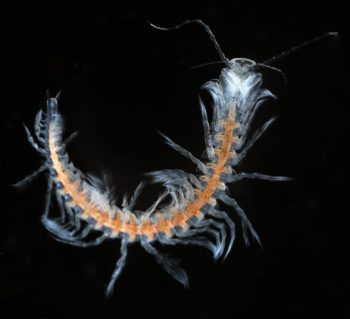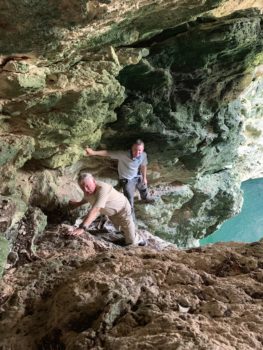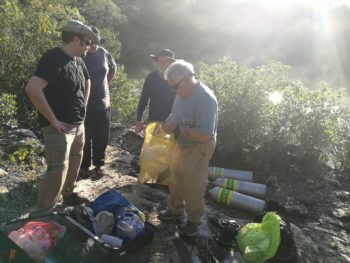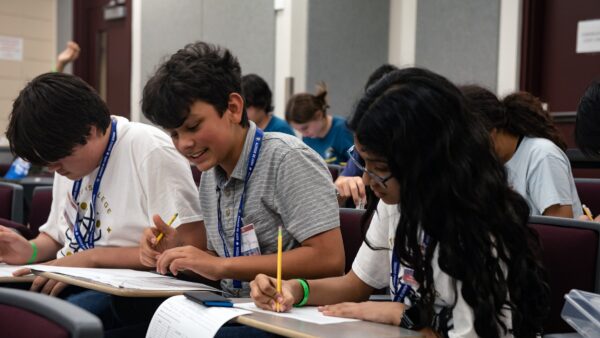
Texas A&M-Led Team Of Cave Divers Discover New Remipede Species In Caribbean
Texas A&M University at Galveston professor Tom Iliffe and his graduate student recently participated in a 10-day research trip to the Caribbean and perhaps hit the marine lottery: they likely discovered at least one new species of ocean life.
“We collected what we believe is a new remipede species, likely related to those found in the Yucatan Peninsula of Mexico,” Iliffe said. “Other new species of cave and marine life will likely be found once further examination is complete.”
Iliffe has explored more than 1,500 underwater caves, more than anyone else in the world. During his 40-year career, he has discovered more than 350 species of marine life. He noted that there is a sense of urgency surrounding his research.
“Time is critical and running out for this research,” Iliffe said. “Many of these caves are in danger of pollution or destruction. One cave in which we found a rich assortment of marine animals on our last trip here, is now polluted and lifeless. If we don’t obtain this information now, it may be lost to us forever.”
Enter the anchialine caves
The multi-national team of elite marine biologists and cave divers was led by former Texas A&M at Galveston graduate student Brett C. Gonzalez, now a postdoctoral researcher in the lab of Karen Osborn at the Smithsonian – National Museum of Natural History, Katrine Worsaae from the University of Copenhagen, and Tom Iliffe, professor of marine biology on the Galveston campus.
Iliffe’s graduate student, Lauren Ballou, also joined the team, coming directly from Denmark where she spent the past five months studying at the Natural History Museum of Denmark, University of Copenhagen. Ballou’s studies are supported by an NSF Graduate Research Fellowship.
The team sought to dive and collect rare animals from anchialine caves in the Turks and Caicos Islands, a group of islands located at the southern end of the Bahamas Archipelago.
Anchialine caves are inland caves containing saltwater pools that rise and fall with the tides. In the depths of such caves, scientific cave divers have discovered an incomparable variety of eyeless and colorless animals. These remarkable species have close relatives from similar cave habitats on opposite sides of the Atlantic Ocean suggesting exceedingly ancient origins.
Investigating cave life
The team’s goal was to obtain biological specimens to investigate the genetic diversity of rare cave life in the area, especially concentrating on swimming scale worms, as well as unique cave dwelling crustaceans known as remipedes. One such scale worm, Pelagomacellicephala iliffei, was named after Prof. Iliffe when he discovered it in 1982.
Another research goal was to understand the molecular mechanisms of adaptation in these rare animals. Both remipedes and scale worms are top predators in saltwater caves, but their lifestyle and evolutionary history are quite different.
Unlike scale worms, the ancestor of remipedes are unknown, but previous research by Gonzalez showed that deep-sea scale worms are closely related to those living in caves.
Gonzalez said the team sought to collect genetic material from the location where the worm was first discovered several decades ago.
Surviving in extreme environments
“I plan to use DNA sequencing technology to investigate similarities between these specimens and those living in the deep sea. This will aid us to understand how animals can adapt and live in such lightless, food poor habitats,” Gonzalez said. “Extreme environments like anchialine caves and the deep sea drive some scale worms into the water column, enabling them to survive as predatory swimmers. Now, our team is the first to capture this swimming behavior on film and use it for detailed video analysis.”
At first glance, remipedes might easily be mistaken for swimming centipedes rather than crustaceans. They have a head and long body with 15-42 similarly shaped segments, each with paddle-shaped limbs. All remipedes are eyeless and lack body pigmentation – typical adaptations to life in the depths of lightless saltwater caves. Four of the 29 known species of remipedes come from caves in the Caicos Islands.
The team was funded by a grant from the Smithsonian’s Global Genome Initiative whose mission is to gather genetic information on all forms of marine life.
“What made the project so successful was its collaboration with a diverse team of experts,” Iliffe said.
The team included:
- Jørgen Olesen (Natural History Museum of Denmark, University of Copenhagen)
- Joost Daniels (Monterey Bay Aquarium Research Institute)
- Alejandro Martínez (National Research Council of Italy, Institute for Water Research)
- Paul Heinerth (Professional Cave Explorer, Florida)
- Students Sarit Truskey and Marc Larsen
On the ground in Turks and Caicos the team was assisted by local consultants:
- Mark Parrish (Big Blue Collective)
- Naqqi Manco (Department of Environment and Coastal Resources)
- Jon Ward (Dive Provo)
The next step for the team is to carry out detailed molecular and morphological analyses of all the specimens collected. This research should provide intriguing insights into evolution and adaptation of animals from these uniquely fascinating cave environments. Later this year, Iliffe and his team will continue their exploration, investigating caves in Belize and the Yucatan Peninsula.
Media contacts:
- Keith Randall, 979-845-4644, keith-randall@tamu.edu
- Tom Iliffe, 409-740-4454, iliffet@tamug.edu
- Brett C. Gonzalez, 949-636-9275, gonzalezb@si.edi





